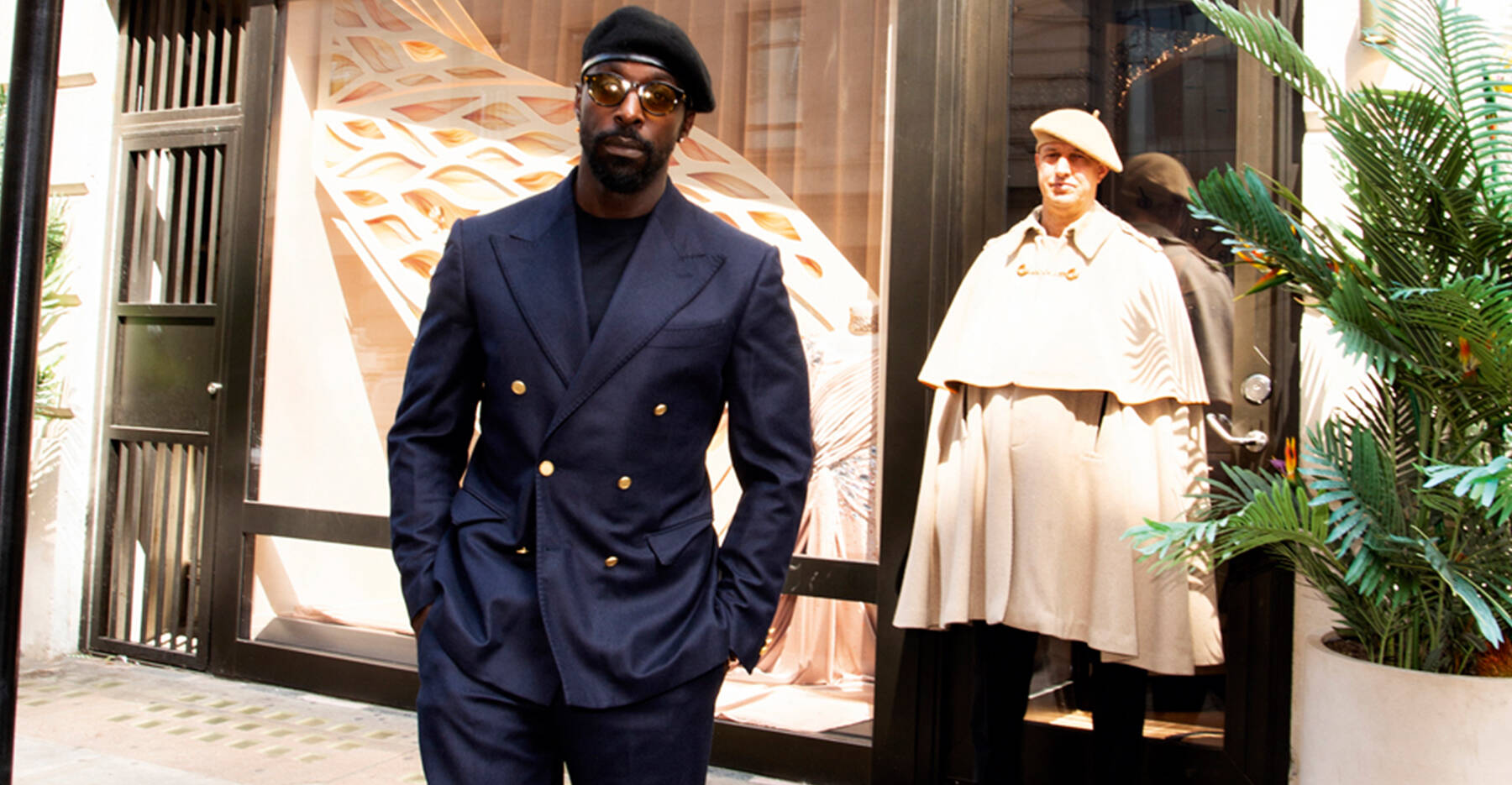
Rewrite
“When people would turn up, they’d realise I’m Black and start asking me funny questions like, ‘Is the jewellery ethical?’ Or, ‘Do they have certificates?’”
We’re sitting downstairs in a plush private room. There’s a big flat-screen on the wall, with only glass separating it from the office, so the vibe is bottle service lounge meets head coach trophy room. A stocked bar is under the stairs, with rows of golden Armand De Brignac champagne bottles on display. A wall of Black excellence peers out from above the office desk, with framed pictures of history-making champions like Anthony Joshua (a friend and regular client) and Michael Jordan (“the first dark-skinned man I saw on TV”). There’s Malcolm X, Maya Angelou, Jay-Z. They’re the barrier-breakers he looks up to and, having overcome so many obstacles to open the first Black jewellery store in Mayfair, it’s a reminder that Appiah is in good company.
Opening nearly two years ago, his store has quickly become a favourite of the Black beau monde (his 100,000 followers number everyone from the President of Ghana and hot rappers like Sexyy Red to mega-streamer IShowSpeed) along with a diverse mix of executives and professionals. From hedge-fund managers and bankers to retired lawyers and doctors, all ages and walks of life enter his shop looking to commission pieces and buy gifts.
From left: Chiefer’s wall of Black excellence, (worn) wraparound bracelet in 18k white gold and diamonds, ring in 18k yellow two tone, yellow diamonds and white diamond ring, ring (held) in 18k white gold and pink diamond ring
“It took the industry a while to embrace what street culture and streetwear actually do for fashion,” he says, listing the Virgils and Pharrells that got it “popping – but the jewellery industry hasn’t got that yet”. Born in Tottenham to Ghanaian parents, he’s the youngest of six boys. At 42 (a year older than Skepta, plus three up from Dizzee Rascal), Appiah is just about old enough to remember how long it took for the culture to break through.
Starting in music, he used to manage his rapper cousin, Sway. At that time, in the UK, “it was not like what it is now… there was no industry. The only way of blowing up was in America and [at that time] it’d never happened.” Still, they dreamed big and ended up getting co-signs from Akon, Lupe Fiasco and Pharrell; starting a record label, Dcypha Productions and signing KSI. They toured the country. A single hit the Top 40, “a big deal”, he says, when you’re independent. “I loved it. But I wasn’t the creator, Sway was. And I’m such a creative: I wanted something to create myself.”
Then, when Appiah hit 30, he lost his right eye. A consequence of sickle cell anaemia, he quickly made a trade. “I remember saying to God: ‘If you let me keep my good eye, I will not waste my talents. I will stop messing about and go and do this jewellery thing.’ He let me keep my one eye. I went to Hatton Garden and, yeah, 10 years later…”
When he first moved into this new central London base, he had a creative block. His ideas dried up and he decided to focus on renovating the store instead. When his idea for a mirrored ceiling didn’t work out, he suddenly said to himself: “You’re in Mayfair. You’re next to the Maddox Gallery. This could be your first art installation.”
in HTML format, including tags, to make it appealing and easy to read for Japanese-speaking readers aged 20 to 40 interested in fashion. Organize the content with appropriate headings and subheadings (h1, h2, h3, h4, h5, h6), translating all text, including headings, into Japanese. Retain any existing
tags from
“When people would turn up, they’d realise I’m Black and start asking me funny questions like, ‘Is the jewellery ethical?’ Or, ‘Do they have certificates?’”
We’re sitting downstairs in a plush private room. There’s a big flat-screen on the wall, with only glass separating it from the office, so the vibe is bottle service lounge meets head coach trophy room. A stocked bar is under the stairs, with rows of golden Armand De Brignac champagne bottles on display. A wall of Black excellence peers out from above the office desk, with framed pictures of history-making champions like Anthony Joshua (a friend and regular client) and Michael Jordan (“the first dark-skinned man I saw on TV”). There’s Malcolm X, Maya Angelou, Jay-Z. They’re the barrier-breakers he looks up to and, having overcome so many obstacles to open the first Black jewellery store in Mayfair, it’s a reminder that Appiah is in good company.
Opening nearly two years ago, his store has quickly become a favourite of the Black beau monde (his 100,000 followers number everyone from the President of Ghana and hot rappers like Sexyy Red to mega-streamer IShowSpeed) along with a diverse mix of executives and professionals. From hedge-fund managers and bankers to retired lawyers and doctors, all ages and walks of life enter his shop looking to commission pieces and buy gifts.
From left: Chiefer’s wall of Black excellence, (worn) wraparound bracelet in 18k white gold and diamonds, ring in 18k yellow two tone, yellow diamonds and white diamond ring, ring (held) in 18k white gold and pink diamond ring
“It took the industry a while to embrace what street culture and streetwear actually do for fashion,” he says, listing the Virgils and Pharrells that got it “popping – but the jewellery industry hasn’t got that yet”. Born in Tottenham to Ghanaian parents, he’s the youngest of six boys. At 42 (a year older than Skepta, plus three up from Dizzee Rascal), Appiah is just about old enough to remember how long it took for the culture to break through.
Starting in music, he used to manage his rapper cousin, Sway. At that time, in the UK, “it was not like what it is now… there was no industry. The only way of blowing up was in America and [at that time] it’d never happened.” Still, they dreamed big and ended up getting co-signs from Akon, Lupe Fiasco and Pharrell; starting a record label, Dcypha Productions and signing KSI. They toured the country. A single hit the Top 40, “a big deal”, he says, when you’re independent. “I loved it. But I wasn’t the creator, Sway was. And I’m such a creative: I wanted something to create myself.”
Then, when Appiah hit 30, he lost his right eye. A consequence of sickle cell anaemia, he quickly made a trade. “I remember saying to God: ‘If you let me keep my good eye, I will not waste my talents. I will stop messing about and go and do this jewellery thing.’ He let me keep my one eye. I went to Hatton Garden and, yeah, 10 years later…”
When he first moved into this new central London base, he had a creative block. His ideas dried up and he decided to focus on renovating the store instead. When his idea for a mirrored ceiling didn’t work out, he suddenly said to himself: “You’re in Mayfair. You’re next to the Maddox Gallery. This could be your first art installation.”
and integrate them seamlessly into the new content without adding new tags. Ensure the new content is fashion-related, written entirely in Japanese, and approximately 1500 words. Conclude with a “結論” section and a well-formatted “よくある質問” section. Avoid including an introduction or a note explaining the process.


